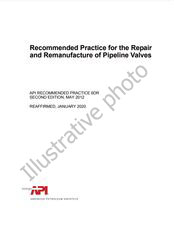We need your consent to use the individual data so that you can see information about your interests, among other things. Click "OK" to give your consent.

API PUBL 4601-ed.1994
Transport and Fate of Dissolved Methanol, Methyl-Tertiary-Butyl- Ether, and Monoaromatic Hydrocarbons in a Shallow Sand Aquifer Appendix H: Laboratory Biotransformation Studies
Translate name
STANDARD published on 1.4.1994
The information about the standard:
Designation standards: API PUBL 4601-ed.1994
Publication date standards: 1.4.1994
SKU: NS-1139774
The number of pages: 347
Approximate weight : 1072 g (2.36 lbs)
Country: American technical standard
Category: Technical standards API
Annotation of standard text API PUBL 4601-ed.1994 :
API PUBL 4601, 1994 Edition, April 1994 - Transport and Fate of Dissolved Methanol, Methyl-Tertiary-Butyl- Ether, and Monoaromatic Hydrocarbons in a Shallow Sand Aquifer Appendix H: Laboratory Biotransformation Studies
BACKGROUND
This report presents the findings of a natural gradient tracer test and related laboratory experiments that investigate the subsurface behavior and impacts of methanol and MTBE. The primary goals of the research were to:
- 1) describe the transport and fate of methanol and MTBE in groundwater; and
- 2) determine the influence of methanol and MTBE on the transport and fate of BTEX in groundwater.
The research was designed to compare and contrast the effects of groundwater contamination by three fuel blends:
- 1) 100% gasoline (control)
- 2) 90% gasoline plus 10% MTBE
- 3) 15% gasoline plus 85% methanol
The study was confined to an evaluation of the dissolved constituents of plumes expected to emanate from spills of these fuels. Behavior of the nonaqueous phase and near-source dissolved phase is being addressed elsewhere (Poulsen, et al., 1991; API/CPPI in review).
Research to date has emphasized the transport and fate of the principal monoaromatic hydrocarbons in gasoline - benzene, toluene, ethylbenzene, and the xylene isomers (collectively termed BTEX) - in groundwater. These compounds represent some of gasolines most water soluble, mobile components. Benzene, a known human carcinogen, is of particular concern (USEPA, 1984) and has a drinking water limit of 5 µg/L in many areas.
Previous studies of the behavior of BTEX in the subsurface have investigated the fate of these compounds in pure form or as derivatives of gasoline with no additives. The research has lead to a broad understanding of BTEX fate, particularly in shallow, aerobic groundwater settings. However, many retail gasoline now contains octane-enhancing additives, typically oxygen-bearing compounds (oxygenates) such as alcohols and ethers.
These additives pose special concerns with respect to groundwater quality because they have higher water solubilities than most other gasoline constituents. They can be expected to occur in extremely high concentrations in groundwater contacted by oxygenate-bearing fuels (API, 1991), and have the potential to influence the subsurface behavior of BTEX. Little is known about the effects of oxygenates on the migration and fate of BTEX in groundwater. The subsurface behavior of the oxygenates themselves has also received little scientific attention. Investigations of the environmental consequences of oxygenate use are needed for informed decision-making on alternative fuel policies.
Two oxygenates, methanol and methyl-tertiary-butyl-ether (MTBE) are the focus of this study. MTBE is used extensively in gasoline in the U.S., principally to meet Clean Air Act requirements, but also as an octane enhancer. Use of methanol as an alterative fuel for vehicles, both in pure form and in an 85% methanol and 15% gasoline blend, has been considered in the United States at both the state and federal level.
Properties of methanol, MTBE and the monoaromatics are listed in Table 1-1. Both oxygenates are highly soluble in water: MTBE has a solubility of 48,000 mg/L and methanol is completely miscible. In contrast, pure-phase BTEX solubilities range from about 200 mg/L (xylenes) to about 1,800 mg/L (benzene). Therefore, the two oxygenates can be expected to occur in high concentrations relative to BTEX at gasoline spill sites. The oxygenates will also be more mobile in the groundwater environment than hydrophobic compounds such as BTEX.
When gasoline is spilled, the nonaqueous phase moves through the soil zone and pools at the water table, leaving behind residual hydrocarbons. Soluble gasoline constituents dissolve into the groundwater and are carried in the direction of flow. The near-source concentrations of the solutes will depend on a variety of factors, in particular their relative proportions in the gasoline blend.
As they move away from the source, dissolved gasoline constituents are affected by advection, dispersion, sorption, volatilization at the capillary fringe, and biological or chemical transformation. Dispersion reduces peak concentrations, providing some natural attenuation, but it also increases the volume of the subsurface that is contaminated. Sorption slows the bulk migration rate of the solutes. Volatilization transfers the contaminant problem to the soil gas, and is probably not an important mass removal mechanism for the dissolved phase below the water table. Chemical and biological transformations are the only processes that provide permanent removal of contaminant mass from the environment.
Near an oxygenated gasoline source, high concentrations of methanol have the potential to increase the levels of BTEX in groundwater by cosolvency effects, but such increases are not expected for MTBE fuels (API, 1991). Elevated BTEX solubilities could increase the mobility of these contaminants, since sorption and solubility are generally inversely related for nonionic organic compounds (Chiou et al., 1979). Oxygenates could also affect the long term fate of BTEX in groundwater systems by inhibiting biotransformation of these compounds.
Research has shown that the limiting factor in BTEX persistence in groundwater is biodegradation (Barker et al., 1989). The monoaromatics are biotransformed under a wi


 Cookies
Cookies
